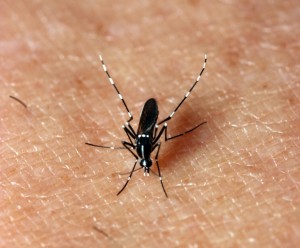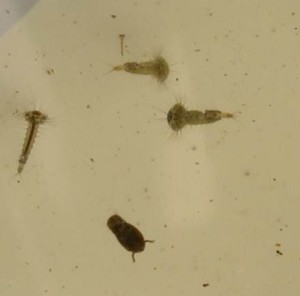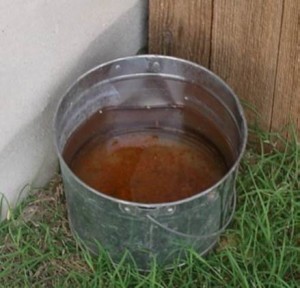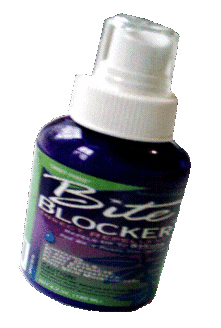Mosquitoes By: Wizzie Brown, Extension Program Specialist III – IPM

The Aedes albopictus or Asian tiger mosquito (shown here) is one of the two mosquito species known to commonly transmit chikungunya. The other is Aedes aegypti. Both species are found in Texas. (Texas A&M AgriLife Extension Service photo by Mike Merchant
Mosquitoes are a hot news item currently, especially those transmitting a new virus….Zika. (At the end of this article you will find a handout designed to help you educate others about Zika.) Mosquitoes can transmit various diseases to humans and animals such as heartworm in dogs and cats, as well as encephalitis (including West Nile Virus), Chikungunya, dengue, yellow fever, malaria and filariasis among humans.
Aedes mosquitoes transmit diseases such as Zika virus, Chikungunya, yellow fever and dengue. These mosquitoes are found in Texas and are active during the day. Most people don’t consider protecting themselves from mosquitoes except at dawn and dusk, so please, protect yourself when outdoors and educate your students/teachers. These mosquitoes are common in backyards and hatch eggs in containers and other areas where small amounts of water are found. (Remember these houses surround your schools.)

The larval stage of the mosquito is aquatic. The larvae are legless and spend a majority of time at the surface of the water. The larval stage is commonly referred to as “wriggler” or “wiggler”, due to the lashing movements of the abdomen that move them forward, backward, or sideways in the water.
Female mosquitoes require a blood meal for egg production; males feed on nectar and do not bite. Eggs can be laid on the surface of water or in dry
locations that are flooded by water. Some eggs are able to remain dormant under dry conditions for several months. Eggs hatch into larvae, or wigglers. Mosquito larvae live in water and feed on organic debris or microscopic plants and animals. Larvae molt into pupae which do not feed. Mosquito pupae spend the majority of their time at the surface of the water, only moving when disturbed.
Work with your District to carry out an integrated mosquito management plan. You will need to eliminate all sources of standing water. Containers such as watering cans, buckets, tire swings, birdbaths, bottles, and other items can turn into mosquito breeding grounds. Standing water should be drained at least once a week. Tree holes should be filled with sand or expanding foam, or drained after each rain. Leaky faucets and pipes located outside should be repaired. Rainwater collection systems should be sealed so mosquitoes cannot enter and lay eggs.

Any temporary body of water that is present for more than a week can be a mosquito breeding habitat.
Areas that cannot be drained, such as ponds, can be stocked with fish that eat mosquito larvae. Products containing Bacillus thuringiensis israeliensis can also be used in these areas. This active ingredient disrupts the life cycle of the mosquito and is non-toxic to humans, amphibians and fish. Dunks are not for use in drinking water sources.
Encourage students, teachers and outdoor workers to wear loose-fitting, light colored clothing with long sleeves & long pants when outside. Also, encourage using mosquito repellents, below are some suggestions about repellents.
Repellent Quick Tips
- Repellent should only be applied to clothing and ex-posed skin.
- Do not apply repellent underneath clothing!
- If you want to apply repellent to your face, spray your hands with repellent and rub it onto your face.
- Do not spray repellent directly into your face or near eyes or mouth.
- Make sure to apply repellent outdoors.
- Do not allow small children to handle repellents.
- After applying repellent, wash hands before eating, smoking or using the restroom
Mosquito Repellents
The Center for Disease Control (CDC) recommends using a product registered with the EPA (Environmental Protection Agency) containing one of the following active ingredients: DEET, picaridin, IR3535 and some of the products containing oil of lemon eucalyptus.
DEET, also known N, N-diethyl-m-toluamide or N,N-diemethylbenzamide, was developed by the U.S. Army in 1946 to protect soldiers in insect-infested areas. Pesticides containing DEET have been used by the general public since 1957. Products containing DEET should not be used on children younger than 2 months of age. DEET has a slight odor and may have a greasy feel to some people. It may damage plastic, rubber, vinyl or synthetic fabrics. DEET may be irritating to the eyes and skin for some people. DEET comes in a wide variety of concentrations, so choose the one that will work best for your situation.
Picaridin was first made in the 1980’s and resembles a natural compound called piperine (which is found in plants used to produce black pepper). Picardin has been used in Europe and Australia for many years, but has only been in the U.S. since 2005. Picaridin is non-greasy and odorless.
IR3535, or 3-[N-Butyl-N- acetyl]-aminopropionic acid, ethyl ester, was developed in the mid- 1970’s and became registered for use in the U.S. in 1999. It is registered as a biopesticide by the EPA because it is function-ally identical to a naturally occurring substance (an amino-acid). It may dissolve or damage plastics and may be irritating to the eyes.
Oil of lemon eucalyptus (OLE) or PMD (para-menthane-3, 8-diol) are essentially the same thing; PMD is the synthesized (lab created) version of oil of lemon eucalyptus. “Pure” or “essential” oil of lemon eucalyptus is not labeled as a repellent and has not undergone testing and should not be used as a repellent product. OLE/PMD has been on the market in the U.S. since 2002. OLE/PMD should not be used on children younger than 3 years of age. The natural product (OLE) has known allergens within it while the synthetic version (PMD) has less of a risk to allergens. This product is classified as a biopesticide. OLE/PMD has a varying range of residual, some offering about 20 minutes of protection while other products may last up to two hours.
- Many factors play into how long a repellent will last for a person. Some of these are:
The concentration (or percent of active ingredient) of the product. You can find the percentage on the product label. - Person’s attractiveness. Some people are more attractive to mosquitoes than others (and no scientific research has proven that it is because of eating garlic, taking vitamin B, using tobacco products, etc.). A person’s genetic code plays a large part on what makes a person so attractive to mosquitoes.
- Frequency and uniformity of application. In other words, how often is the repellent applied and how good of coverage did you get? Activity level of the person. The more active the person is, the more sweat they produce which can cause the repellent to wash off the surface of the skin.
For More Information on the Zika Virus and mosquito management, fire ants and the upcoming programs in Bexar County Extension follow this link for Bexar County Extension newsletter: HERE
What Texans need to know about Zika virus (PDF Flyer to help educate all Texans)


 .
.